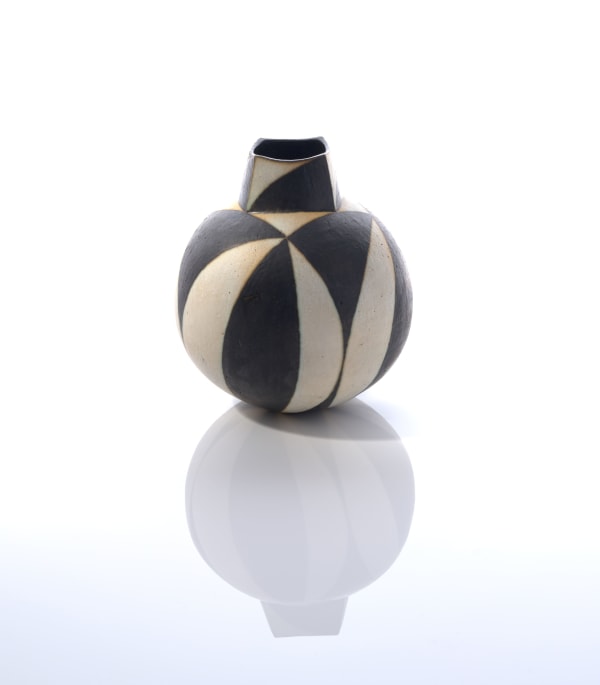John Ward British, 1938-2023
“Clay has limitless possibilities of expression … Pots can be the focus of so much history and associations” JOHN WARD
Born in London in 1938, John Ward had only very limited experience of clay as a child, and it was not until he attended evening lessons at East Ham Technical College whilst working as a cameraman for the BBC that he began to fully explore the vast versatility of the medium. This spurred him on to enrol on the Foundation Course of the Diploma in Art & Design at Camberwell School of Arts & Crafts in 1966. Ward was drawn to Camberwell by two tutors working there – Lucie Rie and Hans Coper.
Austrian-born Rie irrevocably changed the course of ceramics in Britain, and attitudes towards the medium through her elegantly thrown earthenware and stoneware vessels which became a familiar appearance on the London art scene from the 1950s onwards. Rie’s teaching was not very hands on, and instead she allowed her students the freedom to explore and express through clay. As such Ward did not opt for throwing as his preferred technique of construction, but rather hand-building, using thick, flattened coils of clay. At Camberwell he explored the vast and varied colours achieved through different glaze components (and even developed a white glaze based on one of Rie’s own recipes). By his final year he had caught the attention of leading figures within the craft community, including Henry Rothschild, whose Primavera Gallery was at the forefront of the contemporary ceramics scene in London.
In 1978 Ward left London with his young family and settled in rural North Pembrokeshire. Over the coming decades his success and popularity continued to rise through galleries such as The Peter Dingley Gallery in Stratford-upon-Avon; the burgeoning ceramics auctions at Christies and Bonhams - led by Cyril Frankel and his firmly established and expansive body of private collectors who clamoured to buy new work as and when it became available. 1976 saw the artist’s first major showing in the United States at Pennsylvanian State University Museum of Art, which was soon followed by shows at Graham Gallery in New York. In 1985 Ward exhibited alongside the recently graduated Magdalene Odundo at the Bluecoat Display Centre in Liverpool, and as the 1980s and ‘90s continued Ward’s work was regularly shown and illustrated alongside leading contemporary names such as Jennifer Lee, Elisabeth Fritch and fellow Camberwell graduate Ewen Henderson.
In recent years Ward’s popularity has continued to soar as new audiences are exposed to his breathtakingly beautiful and beguiling works. In 2016 fashion designer Jonathan Anderson showed Ward’s work alongside that of William McKeown at Loewe in Miami during Art Basel Miami Beach, and it is notable that for the front cover of Alun Graves’ 2023 book cataloguing the impressive collection of ceramics at the Victoria & Albert Museum, the curator and author chose a work by Ward to grace the front cover of the book.
Ward stopped working in 2017 due to declining health, and in 2022 shortly before his death a major monograph was published, written by leading crafts writer Emma Crichton-Miller. In many ways John Ward was a potter’s potter, working tirelessly to develop his unique aesthetic language, and refusing to conform to fashions and trends as they came and went. As with Rie, he disliked commenting on the work he created, and instead preferred his ceramics to speak for themselves, whether as individual pieces or grouped together. And speak for themselves they most certainly do – strikingly confident and visually stimulating, they are among the most captivating and bold ceramics produced in Britain in the past fifty years.
-
 Green and White Banded Pot, circa 1990s
Green and White Banded Pot, circa 1990s -
 Monumental 'Russet and Blue-Banded 'Dipped-Rim' Oval Pot, circa 2000s
Monumental 'Russet and Blue-Banded 'Dipped-Rim' Oval Pot, circa 2000s -
 Monumental White 'Shoulder' Pot, circa 2000s
Monumental White 'Shoulder' Pot, circa 2000s -
 Large Ochre-Banded 'Tailed' Bowl, circa 2000s
Large Ochre-Banded 'Tailed' Bowl, circa 2000s -
 Black and White Rounded Pot with Squared Neck, circa early-1990s
Black and White Rounded Pot with Squared Neck, circa early-1990s -
 Large Black and White Disc Pot, circa mid-1990s
Large Black and White Disc Pot, circa mid-1990s







